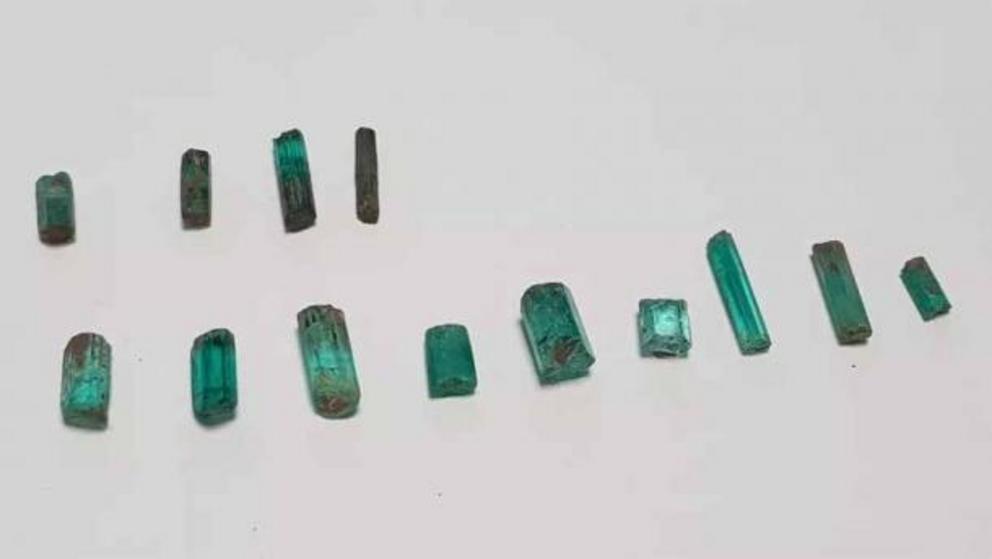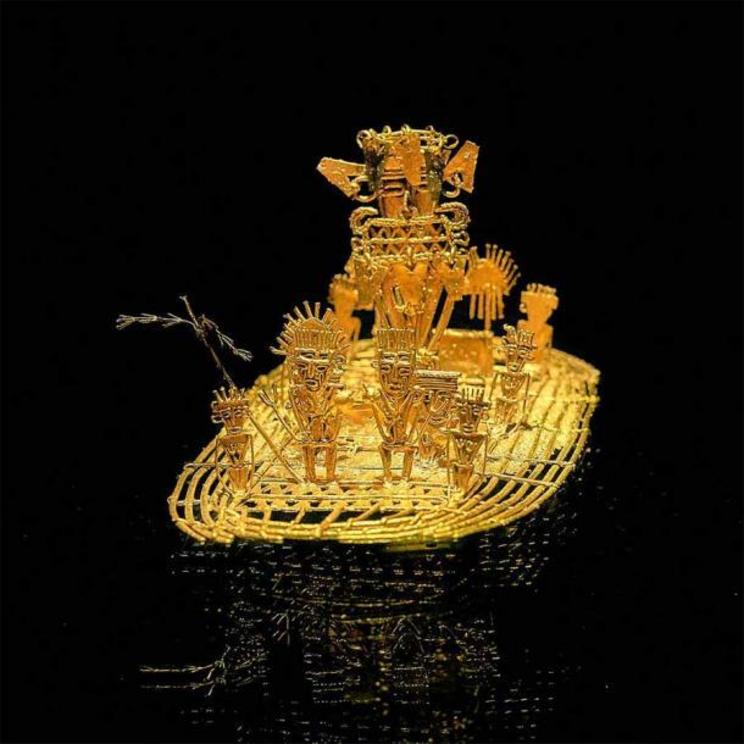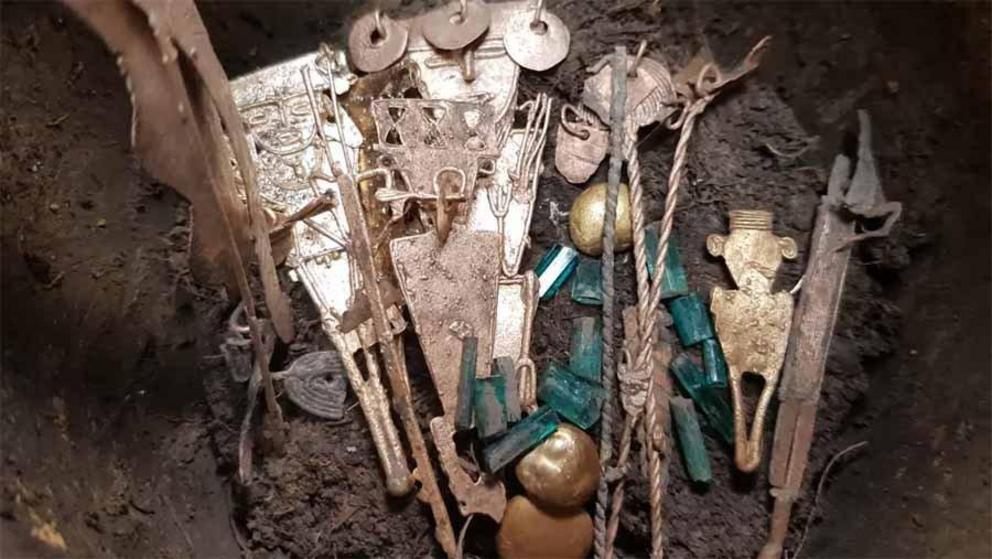Eight jars of Colombian emeralds, gold and silver unearthed near Bogotá
Top image: A closeup look at the treasure as it was found in one of the 8 jars: a mixture of gold and silver Muisca craftwork and many big Colombian emeralds.
Archaeologists in Colombia have discovered a vast treasure hoard that’s being related to El Dorado, the legendary city of gold. But these offerings of gold, silver and Colombian emeralds have nothing to do with El Dorado, which was a creation of 16th-century conquistador folklore.
Eight ceramic jars filled with gold, silver and Colombian emeralds have been discovered at an ancient temple site in Colombia near the capital city of Bogotá. While the media are associating the discovery with the 16th-century Spanish legend of the lost city of gold, El Dorado, these are in fact “Muisca” artifacts, not Spanish artifacts. Now that is clear, let’s ask the question on the lips of many of you, who were the Muisca?
 The incredibly big and priceless Colombian emeralds found in the 8-jar treasure hoard at the ancient Muisca temple site on the edge of modern-day Bogotá.
The incredibly big and priceless Colombian emeralds found in the 8-jar treasure hoard at the ancient Muisca temple site on the edge of modern-day Bogotá.
A Temple Full of Gold, Silver and Lots of Colombian Emeralds
Originally the “ Mhuysqa” or “C hibcha” dominated the central Andean highlands of present-day Colombia from 800 AD until the arrival of Spanish conquistadors in 1537 AD. Mass-producing quality fabrics and mining vast tonnages of salt, the Muisca imported watery-green emeralds from the nearby mountains of Muzo, and all of these commodities were traded with distant indigenous populations for gold.
As one of the four “high” civilizations of South America along with the Aztecs, Mayas and Incas, the Muisca also had advanced metallurgic skills. And they crafted countless gold and silver artifacts studded with Colombian emeralds.
However, whereas in today’s world these metals and stones have a high-monetary value, they had no economic value whatsoever in Chibcha culture . Therefore, the 8-jar hoard find is defined as “treasure” by Western thinking. Gold, silver and emeralds were offered by the Muisca to their gods and goddesses in lagoons, waterfalls, caves, and at temples.
Live Science reported that archaeologists in Colombia recently discovered a Muisca temple site with surrounding graves, where they recovered eight ceramic jars known as “ofrendatarios.” Inside, they found metallic figurines , known as tunjos, among several kilograms of rare Colombian emeralds.
 One of the Muisca ceramic jars found outside Bogotá, Columbia, which contained a large number of rare, uncut Colombian emeralds.
One of the Muisca ceramic jars found outside Bogotá, Columbia, which contained a large number of rare, uncut Colombian emeralds.
Gold For the Sun, Silver For His Wife, the Moon
The team of excavators who uncovered the temple and graves near the capital city of Bogotá was led by archaeologist Francisco Correa, who specializes in pre-construction work archaeology. Live Science said 3D scans at the future construction site identified “cast gold and silver items that resembled snakes and other animals.”
Furthermore, human-shaped votive figurines wearing cloths around their heads were detailed “with weapons and ceremonial staffs” were also found. Tellingly, the metallic figures were discovered among hundreds of large, uncut Colombian emeralds and other semi-precious stones.
Correa told Live Science that the Muisca operated “a type of cult of the ancestors .” The archaeologist also explained that the temple site and ofrendatarios may also be related to deities worshipped by the Muisca including, Sua, the god of the sun , and Chia, the goddess of the moon , who were worshiped as husband and wife. Gold was votively offered to the yellow sun while silver was ritually given to the pale-grey moon.
 The myth of El Dorado comes from this object and the legend behind it. The zipa or Muisca king used to cover his body in gold dust. And from his raft, he offered treasures to the Guatavita goddess in the middle of the sacred lake. This old Muisca traditio
The myth of El Dorado comes from this object and the legend behind it. The zipa or Muisca king used to cover his body in gold dust. And from his raft, he offered treasures to the Guatavita goddess in the middle of the sacred lake. This old Muisca traditio
Shattering the El Dorado Myth
Beginning in the 1530s, Spanish conquistadors in Santa Marta, on Colombia’s Caribbean Sea coast, heard rumors of a lost city of gold hidden deep within the interior of New Granada. Gonzalo Jiménez de Quesada y Rivera became so obsessed with finding El Dorado that he invaded the Muisca territories in the name of the king of Spain, wielding the sword of the Christian god against the wooden clubs of the indigenous warriors. Within four years of arriving in central New Granada in 1537 AD, the Spanish had sacked and plundered every temple site in the Muisca Confederation.
Having myself lived and explored in Colombia for the last five years I know a thing or two about El Dorado. Only three months ago Discovery Channel’s Josh Gates joined me in Colombia on his own search for El Dorado . I introduced Josh to my friend Candil Mamanche, a leader at the Lake Guativita indigenous community. He explained to Josh that the word El Dorado meant “Golden Man” - El (he) Dorado (golden). El Dorado was never a city of gold, but a coronation ritual performed at Lake Guatavita that culminated in a new ruler being covered in powdered gold and jumping from a raft into the water.
The Muisca people of Guatavita were expert metal workers and they produced votive offerings for the entire Muisca Confederation. For this reason, and the fact that the sacred circular lake hosted the El Dorado ceremony, the legend of a lost golden city grew from the folklore and greed of the first Spanish colonists.
Therefore, the eight jars of treasure that were recently discovered at the temple site in Colombia come from a time long before Quesada and his Spanish army marched across New Granada looking for a mythological city of gold.

